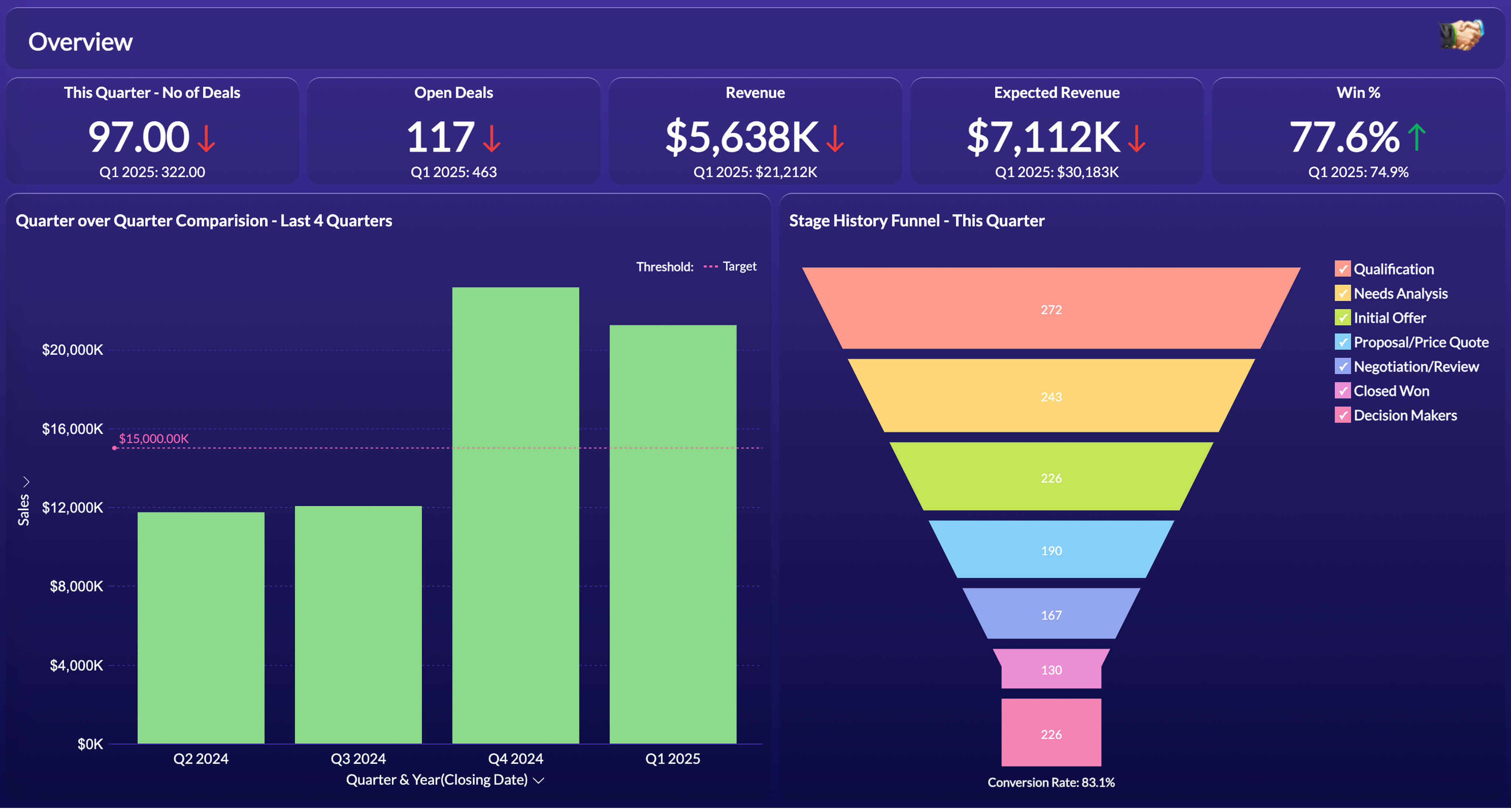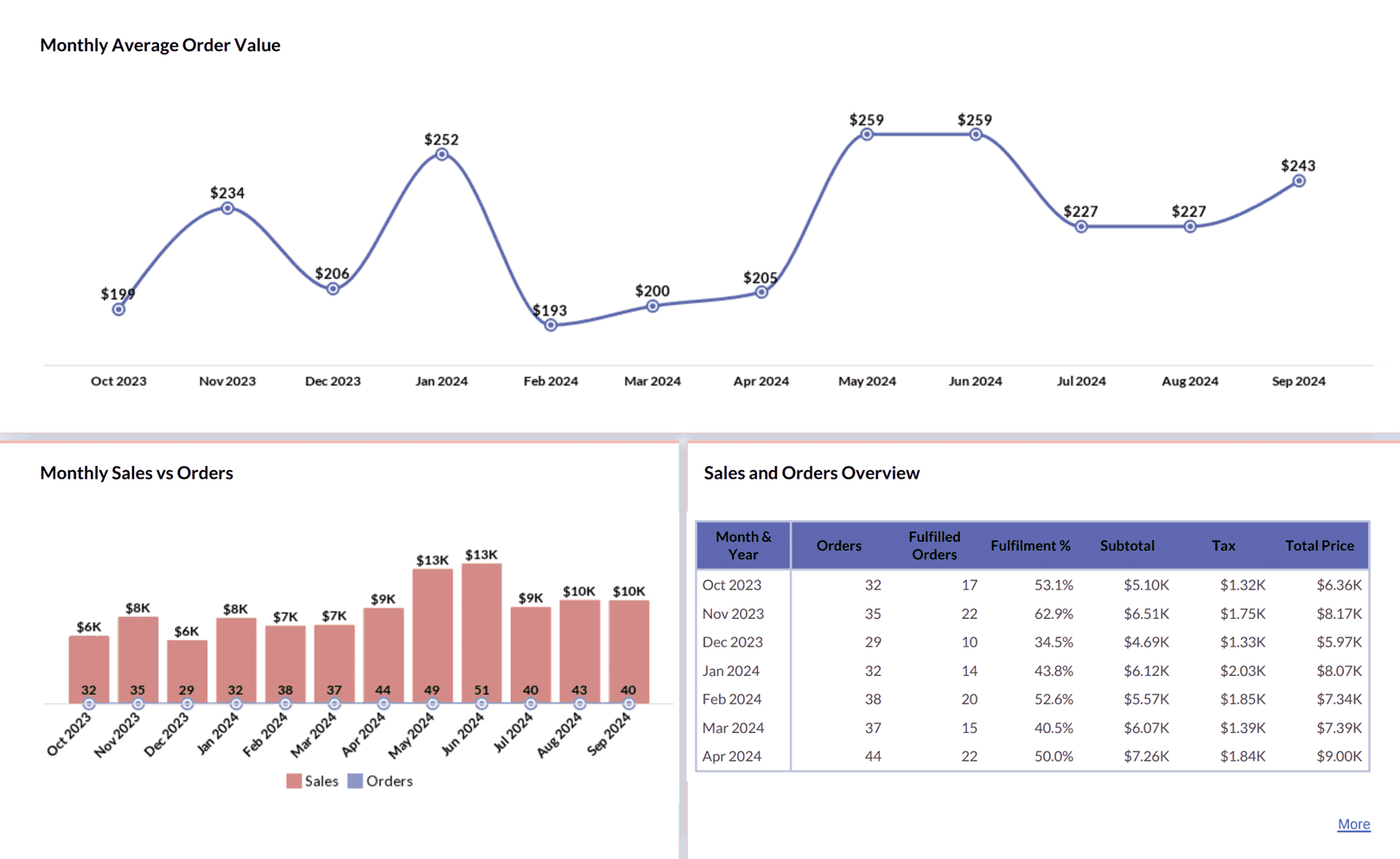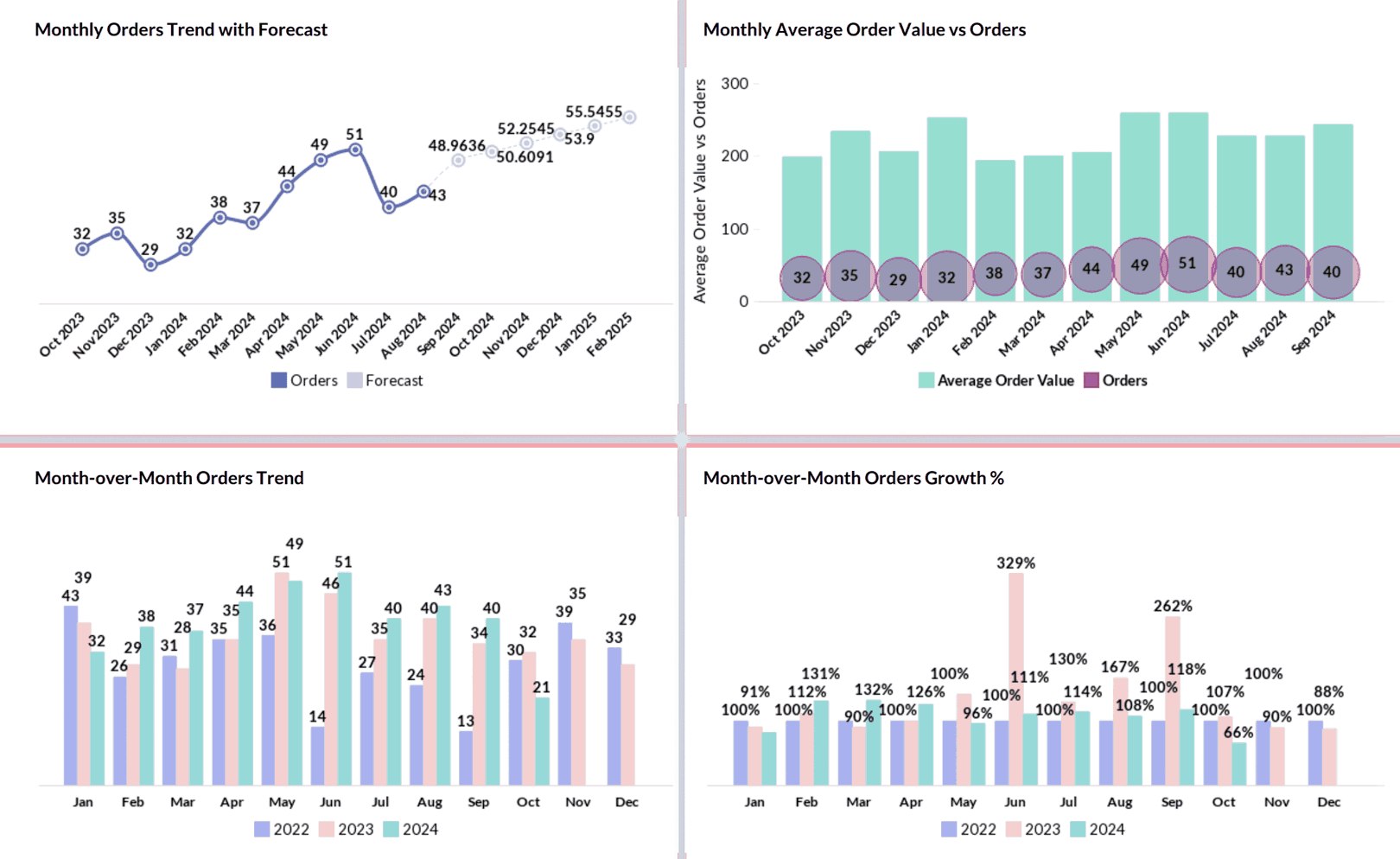What will I learn?
- What is big data analytics?
- How does big data analytics work?
- What are the types of big data analytics?
- Benefits of big data analytics
- Who uses big data analytics?
- Examples of big data analytics
- Challenges in big data analytics
- Big data analytics tools and technologies
- Get started with big data analytics using Zoho Analytics
- Frequently asked questions on big data analytics
Big Data Analytics: What It Is, How It Works, and Examples
What is big data analytics?
Big data analytics refers to the processes and tools to analyze large, varied datasets to uncover insights like trends and patterns. With extracted insights, organizations can make more informed business decisions.
Data analytics techniques comprise data mining, machine learning, natural language processing, data visualization, and predictive analytics
History & evolution of big data analytics:
The concept of big data analytics emerged in the late 1990s when data storage capabilities expanded. The ability to apply advanced analytics techniques matured in the 2000s with open-source frameworks like Apache, Hadoop, and Spark.Then, growth has accelerated as digital transformation drives data proliferation. According to a report by Valuates, the global big data and analytics market size is projected to reach $684.12 billion by 2030, growing at a CAGR of 13.5% from 2021 to 2030.
How big data analytics works?
Big data analytics relies on a multi-step process to extract actionable business insights from massive datasets. The key steps in how big data analytics works are:
Data gathering and storage:
Data is collected from various structured and unstructured sources, which include social media, the web, sensors, log files, etc. Then, the gathered data is stored(read more about data management) in distributed storage systems like data warehouses and data lakes.Data preparation:
Data processing, cleaning, and transformation happen to prepare the data for analysis.Data analytics:
During data analytics, the data is analyzed to find patterns and insights by using advanced techniques like machine learning, predictive modeling, artificial intelligence, etc.Data visualization:
Build Interactive data visualizations like charts, graphs, and create business dashboards to present data insights to stakeholders.Decision-making:
Lastly, the business insights obtained through big data and analytics are used by executives and leaders to devise strategic decisions and plans.
Related read: Key differences between data warehouse, data lakes, and business intelligence
What are the types of big data analytics?
Big data analytics describes the process of analyzing huge datasets to uncover patterns, trends, and insights useful for businesses. Below are the four types of big data analytics.
Descriptive analytics
The following is a storytelling dashboard that can be used by social media managers and agencies to present their Instagram findings as a narrative. You can present this data story to your managers and clients and let them understand how the Instagram profile is performing.
For example, retailers can analyze past sales data to identify buying trends.
Diagnostic analytics
Diagnostic analytics aims to determine why something happened by diving deeper into data. It overlays contextual data points to provide a greater perspective on metrics and KPIs.
For example, a bank may use diagnostic analytics to understand why account closures increased last quarter by analyzing location, demographic, and economic data.
Predictive analytics
Predictive analytics uses past data to forecast future outcomes with data modeling and machine learning. It models data to forecast trends, future demand, and probabilities of specific outcomes.
For example, predicting patient readmission risk using clinical data, or anticipating customer churn based on usage patterns.
Prescriptive analytics
Prescriptive analytics suggests specific actions to take, based on predictive insights. It combines optimization algorithms and machine learning with business rules, to recommend data-driven decisions.
For example, optimizing marketing spend based on predicted customer responses based on expected sales.
Benefits of big data analytics
Key advantages of big data analytics include:
- Identifying new revenue opportunities: By analyzing customer data, organizations can identify emerging needs, changing behaviors, and hidden market segments that represent potential new revenue streams. They can then quickly develop products and campaigns to capitalize on these opportunities.
- Improved operational efficiency: Big data analytics helps spot process bottlenecks, redundancy, and waste and suboptimal activities to streamline operations and reduce costs.
- Better customer experiences: Big data analytics provides insights into customers' preferences, frustrations, and needs so that companies can offer more personalized interactions and appropriate products that strengthen engagement and loyalty.
- Reduced costs and risks: Big data analysis helps detect fraudulent activities and cybersecurity threats early, which ensures companies face lower losses. It also helps to identify ways to control expenses through improved operations and resource allocation.
- Competitive advantages from data-driven insights: The intelligence gained from big data analytics can lead to innovative offerings, optimized pricing, and strategic moves.
- Informed strategic planning: Trends and predictive insights uncovered through analytics inform planning around new market opportunities, partnerships, investments, and resource allocation for future growth.
- Innovation opportunities: Customer data can highlight complaints and emerging trends that provide ideas for new products, services, and business models to meet untapped market needs.
Who uses big data analytics?
Big data analytics has become an essential part of organizations across industries looking to use their data to gain strategic insights and competitive advantage. Some of the key users and beneficiaries of big data analytics are:
- Marketing and sales teams: Analyzing customer data from sources like social media, web traffic, and purchases helps sales and marketing teams identify trends, optimize campaigns, and personalize promotions to boost revenues. Know more on sales analytics
- Financial institutions:Banks, insurance firms, and other financial services rely on big data analytics to analyze real-time risk and make smart investment decisions. Know more on finance analytics
- Healthcare providers: Patient records, clinical data, and genomic databases hold insights that can improve patient diagnosis, treatment, and overall quality of care.
- Government agencies: Government agencies use big data tools to improve security, manage services, and develop effective policies to serve citizens better.
- Manufacturers:Sensor data from production machinery, supply chain data, and customer feedback are invaluable for manufacturers to minimize equipment downtime, streamline supply chains, and improve production quality.
- Retailers:Customer transaction data, loyalty program data, and inventory data guide pricing, stocking, marketing, and other core decisions.Know more on retail analytics
- Media and entertainment: Big data analytics on viewer preferences and engagement allows for better recommendations, more personalized content, and optimized marketing campaigns. Know more on marketing analytics
Sign up with Zoho Analytics for free, start creating compelling data stories, and inspire your stakeholders to take action.
Examples of big data analytics
Big data analytics helps uncover trends and opportunities organizations may otherwise miss. Some examples include:
Customer analytics
Businesses increasingly use big data analytics on customer data from sources like social media, website behavior, purchases, and more to gain insights that improve customer experience and marketing.
- Banks analyze customer usage patterns to address issues and provide personalized offerings to minimize attrition proactively.
- Insurance firms mine data to detect fraud and better calculate risk profiles and premiums.

Operational analytics
Big data analytics helps organizations optimize complex systems, processes, and performance.
- Manufacturers use sensor data from machinery to identify issues and minimize downtime.
- Airlines analyze flight data to improve scheduling, pricing, and other decisions.

Trend analysis
Organizations can identify patterns and changes over time by analyzing large historical datasets to plan strategies.
- Fashion businesses analyze purchasing trends to predict and design future seasons' clothing lines.
- Car manufacturers proactively assess vehicle service records to remedy potential defects and improve future models.

Challenges in big data analytics
Top big data analytics challenges involve the volume, velocity, variety, and veracity of large data sets, including the following:
- Storing and processing large, disparate data
- Ensuring data quality and relevance
- Analyzing data in real-time
- Choosing the right analytics tools and skills
- Organizing messy and unstructured data
- Ethical use of data analytics
- Data privacy and security concerns
Big data analytics tools and technologies
As previously discussed, big data analytics includes a set of tools and technologies. Below are some examples of big data analytics software:
- Zoho Analytics is a big data analytics tool that offers powerful AI-driven analytics and data visualization software capabilities
- Apache Hadoop ecosystem for distributed data processing
- Machine learning libraries like TensorFlow and PyTorch
- Python and R for statistical modeling and analysis
- SQL and NoSQL databases like MongoDB for data storage
Get started with big data analytics using Zoho Analytics
Follow the steps below to start leveraging big data analytics for your organization:
- Identify key business problems to solve with analytics: Focus your analytics strategy on 2–3 top business issues like improving customer retention or optimizing the supply chain. Identifying these key problems provides clarity on the desired business outcomes.
- Assemble a cross-functional analytics team: Include technical experts in data science and engineering and business leaders who can contextualize the data and apply insights in your team.
Related read:The blueprint for setting up a data-first organization
- Inventory available data sources: Catalog and assess internal data like customer transaction history as well as external data like social media feeds.
- Invest in big data infrastructure and tools: Allocate a budget for cloud resources and tools to store, process, analyze, and visualize data at scale.
When it comes to big data analytics software, you can choose a powerful BI and analytics platform like Zoho Analytics.
Here are some reasons why you should choose Zoho Analytics for big data analytics
- Ease-of-use
- Support for on-premise and multi-cloud environments
- Integration with widely used databases/business applications
- Wide range of visualization options
- Robust API library for customization support
- Budget-friendly pricing
If you have completed the first three steps and are exploring big data analytics tools, you can sign up with Zoho Analytics for free and check out its capabilities.
But the journey of big data analytics doesn't end with picking an analytics tool. After setting up the infrastructure and tools, you'll need to follow the steps below:
- Collect, integrate, and clean data: Integrate data from diverse sources and formats. Join, transform, and clean data to create high-quality, unified datasets for analysis.
- Explore and analyze data to derive insights: Use techniques like machine learning, data modeling, and visualization to uncover patterns, trends, and insights that address key business questions.
- Measure ROI and refine approach over time: Track KPIs to quantify benefits and ROI of analytics initiatives. Continually assess performance and refine approaches to improve decision-making over time.
Frequently asked questions on big data analytics
What’s the difference between cloud computing and big data analytics?
Cloud computing is like renting computer storage and services over the internet rather than owning and managing physical hardware. However, big data analytics is about analyzing large amounts of data to find useful patterns and insights that can help in making better decisions or predictions.
What is the difference between big data analytics and data science?
Big data analytics focuses on analyzing large amounts of data to find patterns and insights, using specialized tools for handling massive datasets. On the other hand, data science comprises a broader range of activities, including collecting, cleaning, and analyzing data, and involves statistical methods and machine learning for understanding and predicting trends.
In simple terms, big data analytics is a part of data science, which specializes in dealing with large datasets.
How does data cleaning work in big data analytics?
Data cleaning in big data analytics ensures that the data used for analysis is reliable and free from errors. This includes identifying and fixing errors, standardizing data, removing duplicates, and checking outliers.
Is big data analytics only about analyzing data, or does it also involve data storage?
Big data analytics involves both analyzing data and storing it. Storing data is essential for later analysis, and the analytics process includes extracting valuable insights from the stored data.